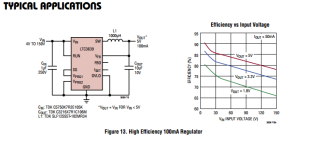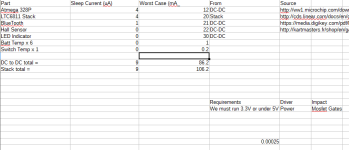methods
1 GW
Spec'ing parts again
I need to step down an arbitrary battery voltage down to 5V.
I need burst power of 60mA or so @ 5V - maybe as little as 30mA but better leave overhead
I need (hopefully) very little average current - converging on 0mA
The linear option (with the obvious limitations)
TL783 4V to 125V, 700mA Linear Regulator
(Can run maybe 7mA @ a 100V drop in a pinch for basically no parts)
Lower Power Switching Option
LTC3639 + external components
4V to 150V @ 100mA
You can get about 70% efficiency out of it with an epic drop from 150V to 5V
I imagine cooling will be an issue - have to read the sheets closely
Sleeps at uA's
Higher Power Switching Option
LTC7138 + external components
4V to 140V @ 400mA
Both of the switchers need to run a minimum current to be efficient (yea - seems confusing but true)
You want to size appropriately.
No doubt there are 50 other options on the market.
Really looking for a daughter board with one of these built up already that I can just drop into my circuit - or at least first test on the bench.
I dont have time to let the magic smoke out of every crack-pot over-rated datasheet on the planet
Open to options if you have a favorite
You know I prefer Linear Technology... but thats just because they publish enough information to know how well their part will ACTUALLY work once built.
The LT8630 could work
3V to 100V @ 600mA
Lots of low power options there... I like kick-down modes.
I have yet to actually crank the math on these to see how much power I can actually get across my use case.
Not sure what components to spec, what the cost on those will be, where the design intricacies are...
Here is a long list of others.
http://www.linear.com/parametric/Hi...7,1107,1367,2198,1033,1032!s_1033,1!gtd_!t2_0
As always I want to encourage as much "System on a Chip" as possible... so I will accept a less efficient design if it means fewer external components.
Perhaps I can make the little puck that I desire. Going to have to happen... if I want to support packs over 60V.
Actual Customers use points:
Me @ 4S, 12S, 14S, 28S
One switch, any pack.
-methods
I need to step down an arbitrary battery voltage down to 5V.
I need burst power of 60mA or so @ 5V - maybe as little as 30mA but better leave overhead
I need (hopefully) very little average current - converging on 0mA
The linear option (with the obvious limitations)
TL783 4V to 125V, 700mA Linear Regulator
(Can run maybe 7mA @ a 100V drop in a pinch for basically no parts)
Lower Power Switching Option
LTC3639 + external components
4V to 150V @ 100mA
You can get about 70% efficiency out of it with an epic drop from 150V to 5V
I imagine cooling will be an issue - have to read the sheets closely
Sleeps at uA's
Higher Power Switching Option
LTC7138 + external components
4V to 140V @ 400mA
Both of the switchers need to run a minimum current to be efficient (yea - seems confusing but true)
You want to size appropriately.
No doubt there are 50 other options on the market.
Really looking for a daughter board with one of these built up already that I can just drop into my circuit - or at least first test on the bench.
I dont have time to let the magic smoke out of every crack-pot over-rated datasheet on the planet
Open to options if you have a favorite
You know I prefer Linear Technology... but thats just because they publish enough information to know how well their part will ACTUALLY work once built.
The LT8630 could work
3V to 100V @ 600mA
Lots of low power options there... I like kick-down modes.
I have yet to actually crank the math on these to see how much power I can actually get across my use case.
Not sure what components to spec, what the cost on those will be, where the design intricacies are...
Here is a long list of others.
http://www.linear.com/parametric/Hi...7,1107,1367,2198,1033,1032!s_1033,1!gtd_!t2_0
As always I want to encourage as much "System on a Chip" as possible... so I will accept a less efficient design if it means fewer external components.
Perhaps I can make the little puck that I desire. Going to have to happen... if I want to support packs over 60V.
Actual Customers use points:
Me @ 4S, 12S, 14S, 28S
One switch, any pack.
-methods





